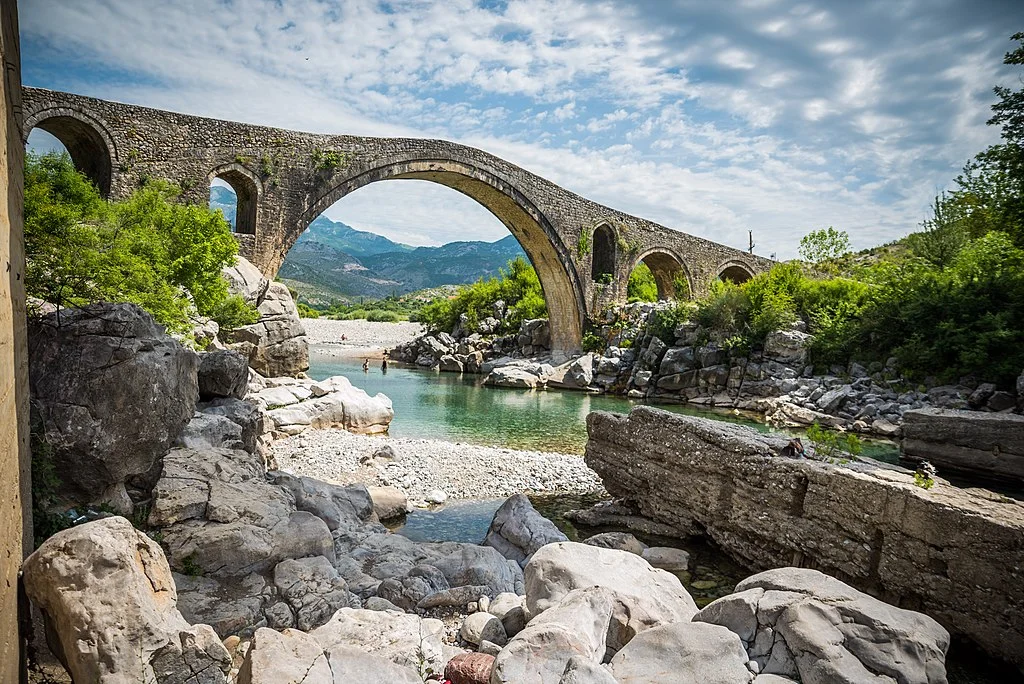
Key Takeaways
- The Mesi Bridge is a well-preserved Ottoman-era monument located in northern Albania.
- Built in the 18th century, it served as a crucial connectivity point for trade and communication.
- The bridge features impressive stone arches, showcasing Ottoman engineering craftsmanship.
- Located near the picturesque village of Mes, it offers breathtaking views of the Albanian Alps and the Kir River.
- As a cultural heritage site, the bridge symbolizes Albania’s rich history and continues to attract tourists and history enthusiasts.
Table of contents
- Historical Background: Construction and Context
- Architectural Features: Design and Materials
- Location and Surroundings: A Northern Albanian Landscape
- Cultural and Tourist Significance: A Heritage Site
- Preservation and Current Condition: Maintaining a Legacy
- How to Visit the Mesi Bridge: A Traveler’s Guide
Historical Background: Construction and Context
The story of the Mesi Bridge begins in the 18th century, around 1770, under the guidance of Mehmet Bushati, a notable Ottoman administrator. Its construction took place over multiple phases, each adding to its impressive structure and strategic importance.
Bushati understood the critical need for a crossing over the Kir River to connect Shkodër with the Dukagjin region. This bridge quickly became a vital route for trade, military movements, and communication—fostering economic growth and cultural exchanges in northern Albania and beyond.
This infrastructure was part of the larger Ottoman strategy to develop robust transportation networks across their territories. The Mesi Bridge’s location highlights its role during a time when the Balkans served as a crossroads of commerce and culture. Several historical events are linked to the bridge, emphasizing its significance in regional development and defense initiatives. Its enduring presence stands as a symbol of Albania’s rich cultural and historical legacy.
Architectural Features: Design and Materials
The Mesi Bridge showcases exceptional Ottoman architectural ingenuity. Spanning approximately 108 meters, it is primarily constructed of locally sourced stone, reflecting resourcefulness of its builders.
The bridge’s most striking feature is its series of stone arches, each different in size and height, demonstrating sophisticated engineering techniques. The central arch is particularly imposing and serves as a visual focal point, designed to accommodate the Kir River’s water flow while ensuring durability.
The varied arch designs not only serve functional needs but also add aesthetic charm, making the bridge visually captivating. Comparing it to other Ottoman bridges such as the Mostar Bridge reveals common design principles—balance, resilience, and beauty—that dominate Ottoman engineering. Recognizing these elements deepens our appreciation of the Ottoman influence on Albanian architecture.
Location and Surroundings: A Northern Albanian Landscape
Nestled in the scenic landscape of northern Albania, the Mesi Bridge offers stunning views for visitors. Situated near the village of Mes, roughly 5 kilometers northeast of Shkodër, it spans the picturesque Kir River.
The setting is characterized by rolling hills that merge with the Albanian Alps in the distance, creating a harmonious natural environment. This peaceful backdrop amplifies the bridge’s historical and cultural importance, making it a favorite spot for travelers, artists, and photographers alike.
Easy access via local roads allows visitors to explore the area leisurely. The surroundings are perfect for **nature walks**, **picnics**, and enjoying the tranquility of the Albanian landscape. Nearby points of interest include scenic spots for relaxation and cultural exploration, making the Mesi Bridge an ideal destination for those seeking both history and nature.
Cultural and Tourist Significance: A Heritage Site
The Mesi Bridge holds immense cultural importance, representing centuries of history, craftsmanship, and regional development. It is a symbol of Albania’s Ottoman past and a testament to the engineering prowess of that era.
It attracts tourists, history enthusiasts, and locals who wish to experience a tangible connection to the country’s heritage. The structure offers insights into Ottoman architectural practices, inspiring admiration for the skills of past artisans. It also plays a role in promoting cultural exchange, helping visitors appreciate Albania’s diverse history.
While not a major festival site, the bridge occasionally hosts local events, storytelling, and folklore, adding to its cultural appeal. Such activities deepen visitors’ connection to the site and preserve local traditions.
Preservation and Current Condition: Maintaining a Legacy
Today, efforts are underway to preserve and restore the Mesi Bridge, safeguarding it for future generations. Restoration projects address natural erosion, weather damage, and structural concerns, aiming to maintain its authenticity and stability.
The bridge is officially protected by Albanian law as a cultural monument. These protections ensure active oversight by the Regional Directorate of Cultural Heritage in Shkodër, emphasizing its significance to national identity.
Restoration efforts involve careful planning to respect historical construction methods and materials. Challenges include environmental factors and funding, but collaboration with heritage conservation experts helps ensure the integrity of the structure.
Maintaining the Mesi Bridge is part of broader efforts to conserve Albania’s historic sites, blending respect for history with sustainable tourism practices. Through continued preservation, this iconic structure remains a symbol of national pride and history.
How to Visit the Mesi Bridge: A Traveler’s Guide
For travelers eager to witness this historic marvel firsthand, visiting the Mesi Bridge is a rewarding experience. The best times to visit are in spring and autumn, when the weather is mild and the scenery is at its most picturesque.
Reaching the site from **Shkodër** is straightforward. Options include renting a car, hiring a local taxi, or engaging a guided tour to enrich your experience with historical insights. While formal guided tours are less common, locals often offer fascinating stories about the bridge’s history.
Photographers can capture stunning images during early mornings or late afternoons, when the light creates a magical atmosphere. Visitors should bring essentials like water, comfortable walking shoes, and camera gear to fully enjoy their exploration.
Exploring the area on foot allows a full appreciation of its natural beauty and serenity. Whether for a day trip or a peaceful stroll, the journey to the Mesi Bridge offers a chance to immerse oneself in Albanian history and nature.
Conclusion: Appreciating Albanian Heritage
The Mesi Bridge is not merely an ancient structure; it is a living embodiment of Albania’s rich cultural tapestry. Its architectural beauty, scenic location, and historical importance serve as a reminder of the ingenuity of Ottoman-era craftsmanship and regional development.
Visiting the bridge provides a meaningful connection to Albania’s past, allowing travelers to witness history firsthand while enjoying the stunning natural surroundings.
As a symbol of national pride, the Mesi Bridge continues to attract those interested in exploring Albania’s heritage. Preserving this monument ensures that future generations can appreciate the artistry and history it represents, fostering a deeper understanding and appreciation of Albanian cultural identity.


0 Comment